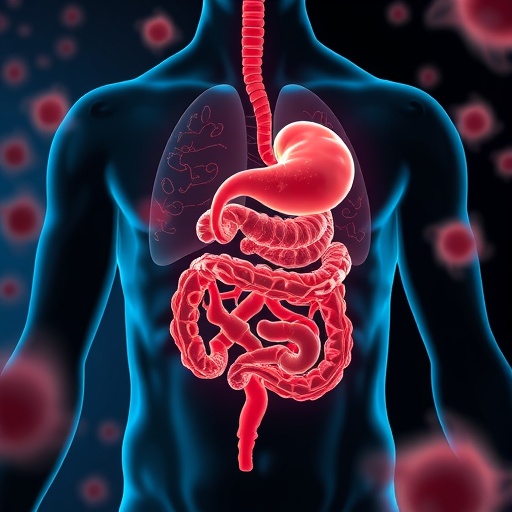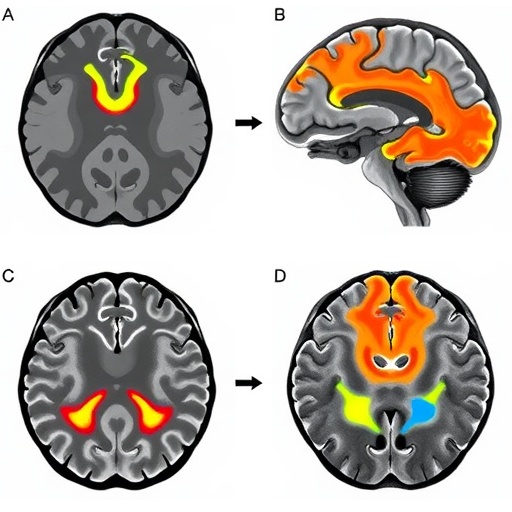The intricate relationship between the gut microbiota and respiratory health has been a burgeoning area of scientific inquiry, shedding light on how microbial metabolites influence systemic immune responses. A recent groundbreaking study published in Nature Communications by Kullberg and colleagues delves into this axis by focusing on the gut microbiota-derived tryptophan metabolite indole-3-acetic acid (IAA) and its profound impact on pneumonia outcomes. This investigation reveals mechanistic insights that could revolutionize our understanding of host-microbe interactions during respiratory infections, potentially heralding novel therapeutic interventions.
The gut microbiota, a diverse community of trillions of microorganisms residing within the gastrointestinal tract, is increasingly recognized as a pivotal modulator of host immunity beyond the local intestinal environment. Among the array of microbial metabolites produced, tryptophan derivatives have garnered attention due to their systemic immunomodulatory properties. Tryptophan, an essential amino acid, undergoes microbial catabolism to yield various bioactive compounds, including indole, kynurenine, and the less studied indole-3-acetic acid (IAA). The current study places IAA under the microscope, linking its production in the gut directly to pulmonary immunity during bacterial pneumonia.
Pneumonia, a leading cause of morbidity and mortality globally, represents a critical context for studying the gut-lung axis. Traditionally viewed as an isolated pulmonary event, emerging evidence implicates systemic factors—such as microbial metabolites—in influencing disease severity and recovery. By probing this interface, Kullberg et al. advance the paradigm that gut-derived molecules mediate immune crosstalk, dictating the host’s defensive capacity against pulmonary infections.
In their experimental model, the researchers utilized murine subjects infected with Streptococcus pneumoniae, a principal bacterium responsible for community-acquired pneumonia. They meticulously quantified and manipulated IAA levels to observe corresponding effects on pulmonary inflammation and bacterial clearance. Crucially, they demonstrated that elevated systemic and pulmonary concentrations of IAA correlated with diminished lung injury and superior bacterial eradication, highlighting IAA’s protective role.
Mechanistically, the study elucidates that IAA engages the host aryl hydrocarbon receptor (AhR) pathway, a well-characterized ligand-activated transcription factor instrumental in modulating immune responses. Activation of AhR by IAA prompts an anti-inflammatory milieu within the lung tissue, attenuating excessive neutrophil recruitment and cytokine storm phenomena that typically exacerbate lung damage during severe pneumonia. This fine-tuned immune response fosters efficient pathogen clearance while preserving tissue integrity.
To substantiate the causal relationship, the authors employed genetic AhR knock-out mice and revealed abrogated protective effects in the absence of this receptor despite the presence of IAA. This finding sharpens the mechanistic narrative, positioning AhR as an indispensable mediator of IAA-driven immunomodulation in pneumonia. Additionally, pharmacological blockade of microbiota pathways responsible for IAA biosynthesis led to worsened infection outcomes, reinforcing the metabolite’s critical defense role.
The translational implications of these findings are considerable. Traditional antibiotic therapies, while effective, pose the risk of disrupting the gut microbial ecosystem and consequently the beneficial metabolites it produces, including IAA. This research underscores the unforeseen ramifications of altering microbiota compositions during infection management and invites a re-evaluation of current treatment paradigms to incorporate microbiome-preserving strategies.
Moreover, the prospect of leveraging IAA or its analogues as adjunctive therapies holds promise. By harnessing these microbial metabolites to modulate immune responses more precisely, clinicians could potentially reduce the deleterious inflammation characteristic of pneumonia while enhancing pathogen clearance. The possibility of administering IAA exogenously or promoting endogenous microbial production opens new avenues in the fight against antibiotic resistance and the pervasive burden of respiratory infections.
Intriguingly, the study also expands the scope of tryptophan metabolites beyond their known gastrointestinal effects, asserting their far-reaching systemic influence. This aligns with evolving perspectives that consider microbiota metabolites as critical molecular mediators of inter-organ communication, integrating the gut environment with distant physiological niches such as the lungs.
Another dimension revealed by Kullberg et al. pertains to the microbiota composition itself. They identify key bacterial taxa responsible for IAA biosynthesis, suggesting that individual differences in microbial communities may contribute to variability in pneumonia severity among patients. This insight advances the feasibility of personalized medicine approaches utilizing microbiome profiling to predict susceptibility and tailor interventions accordingly.
From an immunological standpoint, the study sheds light on the dualistic nature of inflammation during infection. While immune activation is necessary to combat pathogens, unchecked inflammation leads to collateral tissue damage and morbidity. IAA-mediated AhR activation emerges as a natural regulatory mechanism mitigating such detrimental hyperinflammation without compromising host defense, exemplifying the sophistication of host-microbiome symbiosis.
The comprehensive biochemical analyses underpinning this study elucidate the metabolic pathways by which gut bacteria convert dietary tryptophan into IAA, bridging nutrition, microbiology, and immunology. This integration supports broader implications for dietary modulation as a means of enhancing innate immunity, with potential public health ramifications in populations vulnerable to respiratory infections.
Furthermore, the study’s methodological rigor, combining in vivo infection models with metabolomic profiling and gene knockout strategies, offers a robust blueprint for future research investigating microbial metabolites in disease contexts. The use of advanced mass spectrometry enabled precise quantification of IAA levels in systemic circulation and localized lung tissue, reinforcing the validity of the observations.
Given the escalating global burden of respiratory infections accentuated by factors such as antimicrobial resistance and emerging pathogens, these findings arrive at a crucial juncture. They invite an interdisciplinary approach combining microbiology, immunology, metabolism, and clinical sciences to develop innovative therapies beyond conventional antibiotics.
In conclusion, the work by Kullberg and colleagues heralds a novel conceptual framework emphasizing the gut microbiota-derived tryptophan metabolite indole-3-acetic acid as a pivotal modulator in pneumonia. By delineating the protective mechanism mediated through AhR activation, this research opens transformative possibilities for enhancing respiratory infection outcomes via microbiota-targeted strategies. It marks a seminal advancement in our understanding of the gut-lung axis and underscores the therapeutic potential embedded within microbial metabolites, charting a promising course for future investigations and clinical applications.
Subject of Research: The study investigates the role of the gut microbiota-derived tryptophan metabolite indole-3-acetic acid (IAA) in modulating immune responses and outcomes during bacterial pneumonia.
Article Title: Effect of the gut microbiota-derived tryptophan metabolite indole-3-acetic acid in pneumonia.
Article References:
Kullberg, R.F.J., van Linge, C.C.A., Haak, B.W. et al. Effect of the gut microbiota-derived tryptophan metabolite indole-3-acetic acid in pneumonia. Nat Commun 16, 8565 (2025). https://doi.org/10.1038/s41467-025-63611-y
Image Credits: AI Generated
Tags: bacterial pneumonia mechanismsessential amino acids and immunitygut microbiota and respiratory healthgut-lung axis researchhost-microbe interactionsindole derivatives in healthindole-3-acetic acid and pneumoniamicrobial metabolites and systemic immunitymicrobiome influence on respiratory infectionspneumonia outcomes and gut healththerapeutic interventions for pneumoniatryptophan metabolites and immune response





